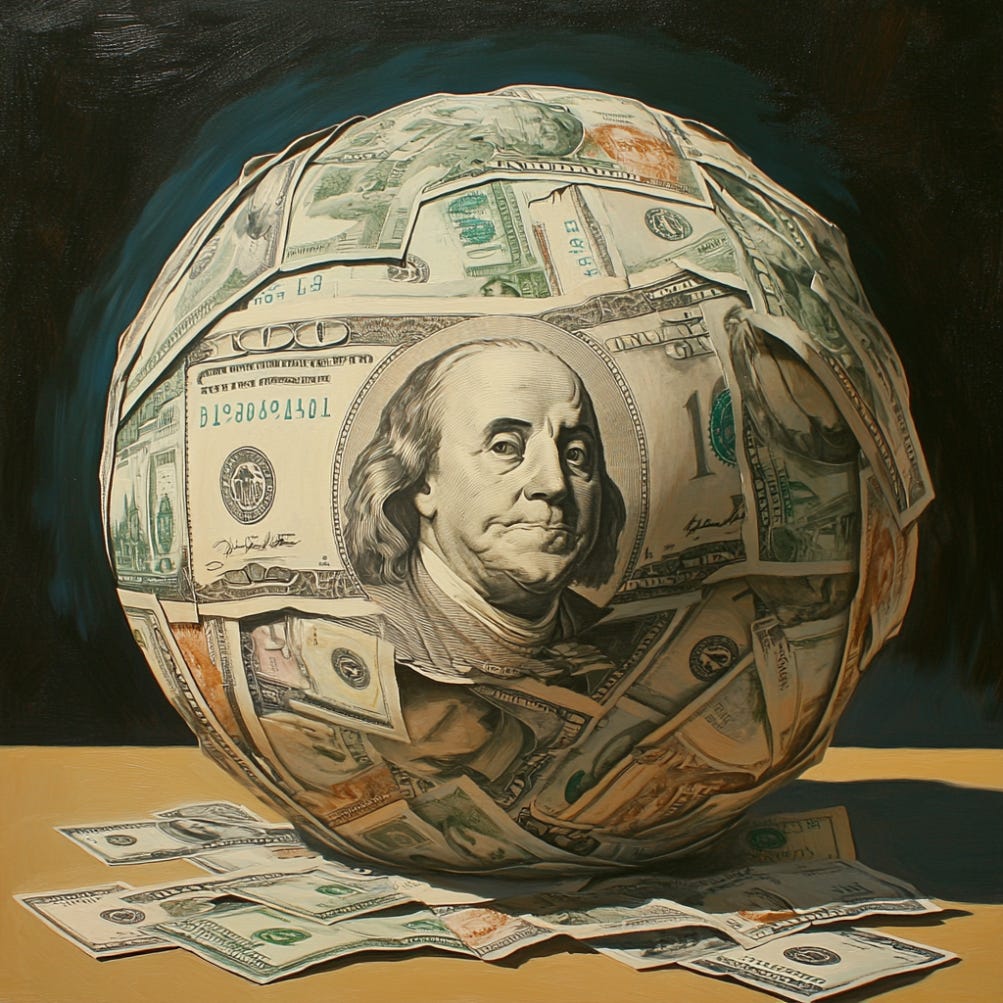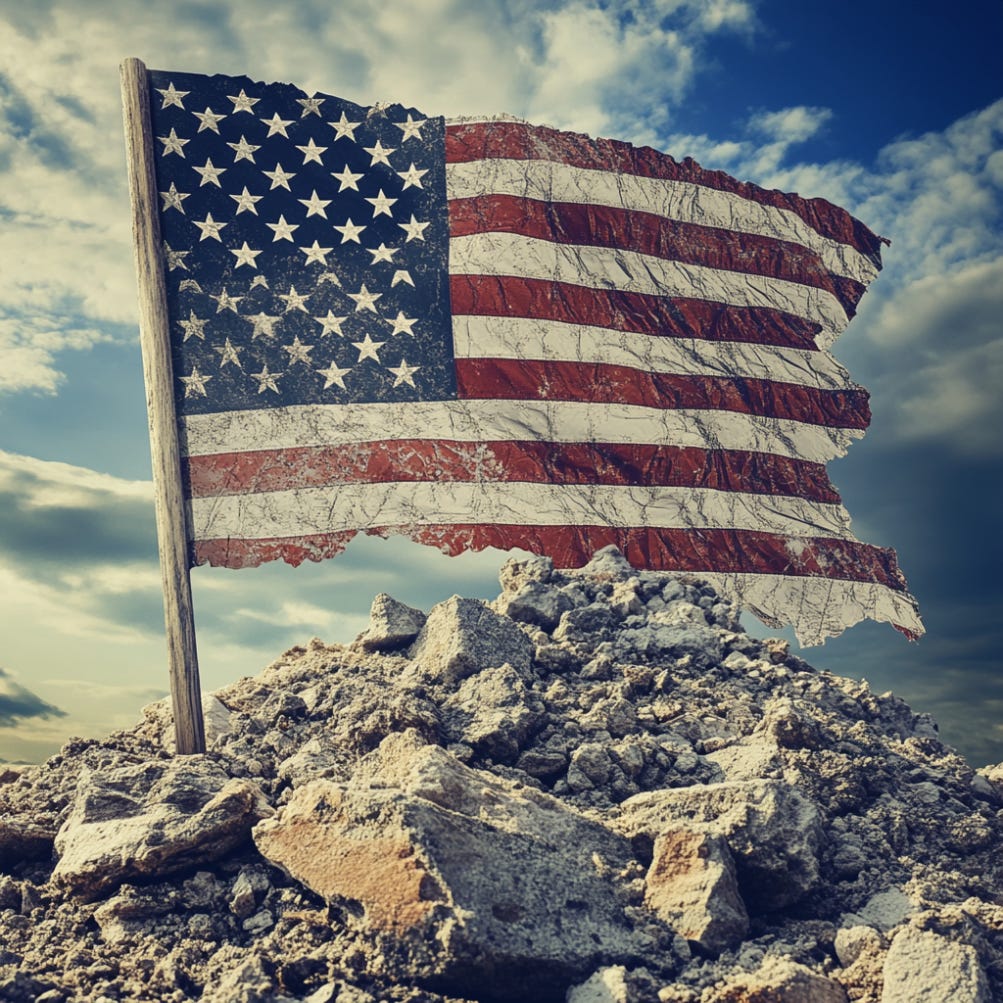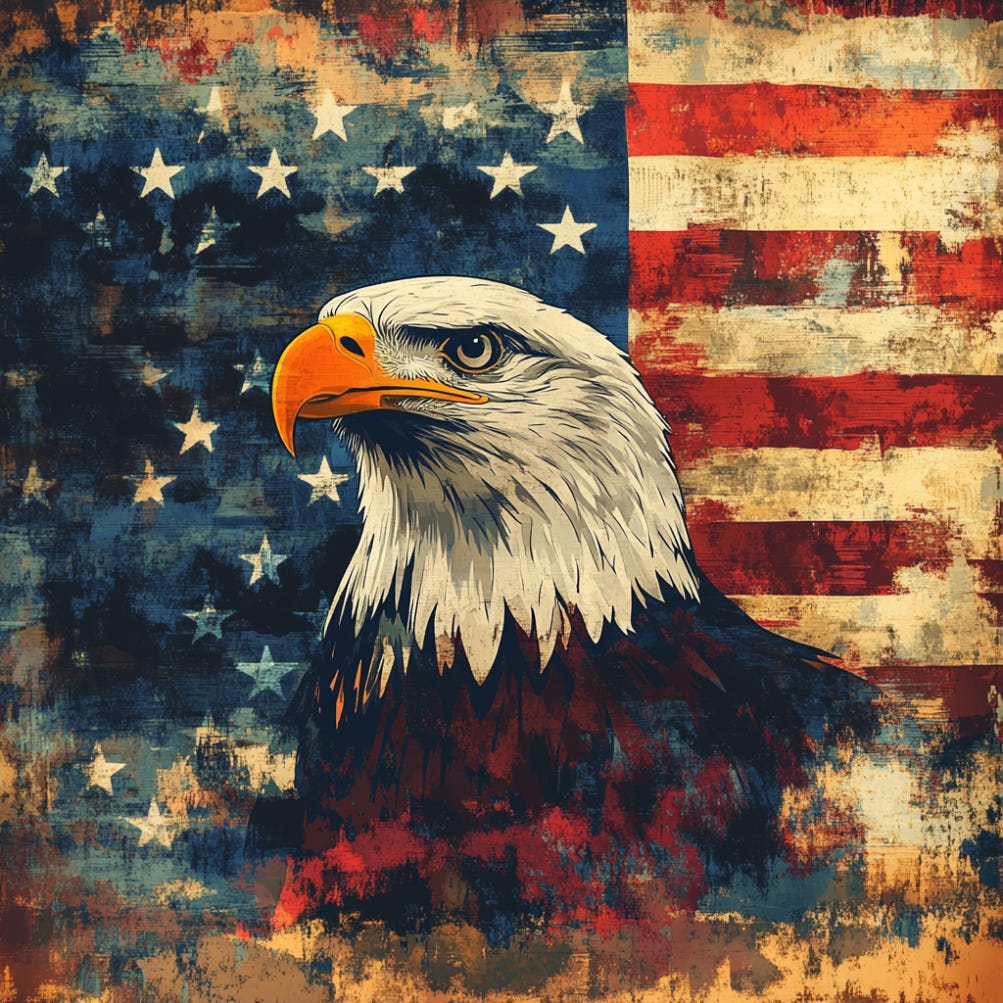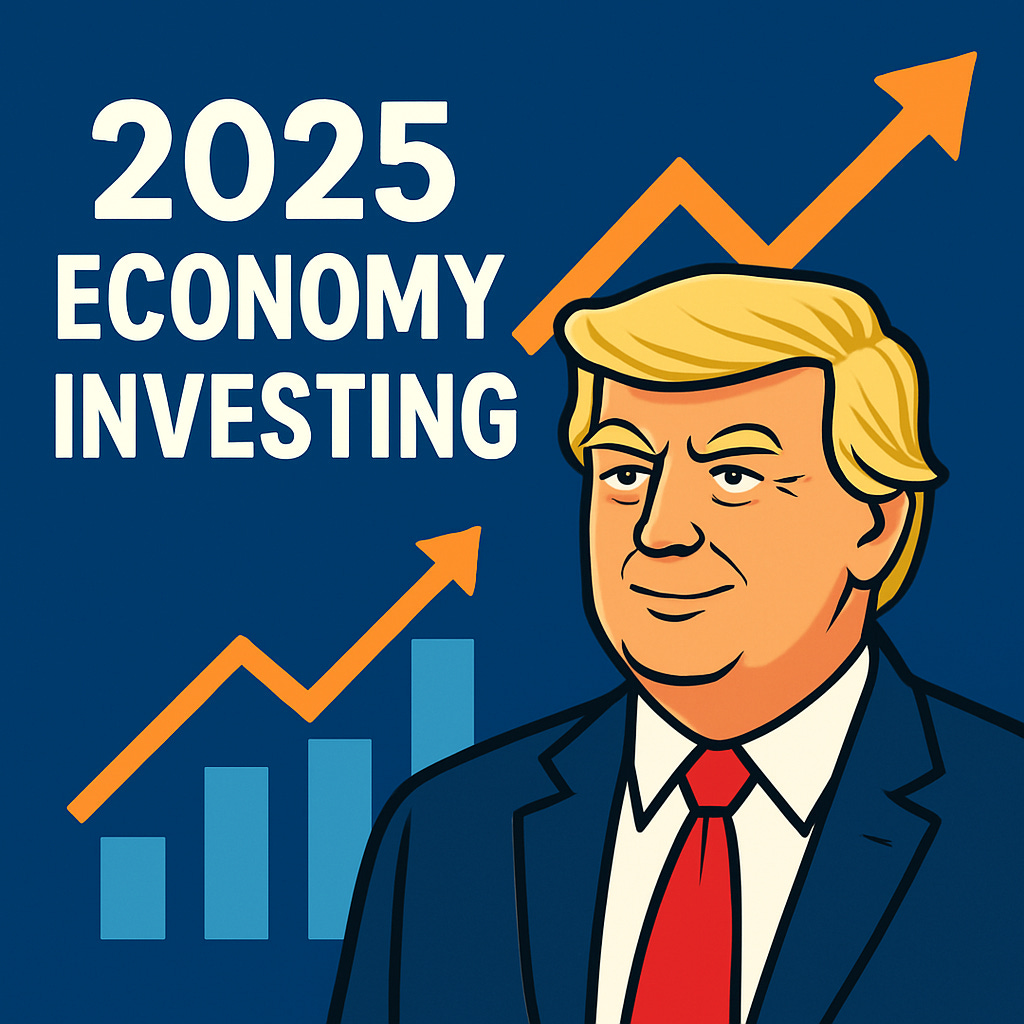Trump's Economy 2025: An Investment Strategy
Evaluating investment strategies under Trump's economic policies in April 2025...
Donald Trump currently has the U.S. economy on a short leash and is dog walking it aimlessly around the White House.
The Trump administration’s hand-picked economic cartel of Scott Bessent, the legendary Ron Vera, Howard Lutnick, and Stephen Miran are clearly not on the same page with each other or with Trump as of April 2025.
How do we know this? They contradict each other in pressers. They’ll say something one day that will be contradicted by their actions the next.
In case you didn’t realize it… economic advisors for Trump were selected primarily based on whether they agreed with Trump’s personal ideas about the economy, international trade, protectionism, and tariffs.
Not all may have fully agreed in their brains, but most were probably like: “Well I can probably make it work — let’s just do what Trump wants and give these tariffs a shot”
Others likely thought Trump would be satisfied with more logical “reciprocal tariff terms” instead of “trade deficit tariffs” and/or be willing to work out some deals (brand them as amazing “Trump deals” even if they are similar to what was already in place e.g. akin to USMCA in Trump 1.0.)
We shouldn’t dismiss the idea that some econ admin members: (1) may have such huge egos that they’ve genuinely convinced themselves that Trump’s trade-deficit tariffs will work/are smart OR (2) want to embrace Trump’s ideas fully (zero pushback) so they retain higher standing within the MAGA social ladder and relationship dynamics.
Perhaps some thought, “I can convince Trump of a smarter policy” and/or “If Trump doesn’t select me for this position — someone will take my place and do a lot of damage” (this may not have happened but it’s worth considering).
So Trump picked people who were fully on board with his tariff ideas… but I doubt most wanted “trade deficit tariffs” (I think the 300 IQ genius that is Ron Vera engineered this idea and Trump loved it.)
Last week MAGA mind virus zombies were on board with tariffs — praising them as “America First” to bring back manufacturing jobs… then Trump paused the tariffs and those same zombies praised the move as an amazing strategy (right out of “Art of the Deal”).
Trump’s Liberation Day Tariffs: This will bring back manufacturing jobs! (Read: Trump Tariffs & Manufacturing Myths)
Art of the Deal: The 90 day tariff pause is a good thing ‘cuz deals! (Related: Is Trump Actually a Good Deal Maker? AI Analyzes His Deals.)
Unfortunately, nobody has a fucking clue what’s coming next. Things have gotten so brutally incoherent that I’m convinced not even Trump knows what’s coming next from his own brain or economic team… they have ideas, then get slapped by China and the 10Y Treasury yields and backtrack.
Maybe they’re using ChatGPT to brainstorm ideas or create better tariff formulas? (If you’re doing this guys at least get someone who is decent at prompting. Please don’t come up with another pathetic trade deficit formula with greek symbol spam in attempt to cosplay as Terrance Tao.)
But yeah… nobody really knows what’s going on. Will tariffs increase tomorrow? Will Trump revoke tariffs tomorrow? Will he keep teeter-tottering back/forth so his cronies can profit from insider trading? Your guess is as good as anyone’s.
As a result of the uncertainty, businesses will likely shitcan less productive employees at a faster clip because they need to free up cash to prepare. Many businesses are already getting crushed by the 10% tariffs.
Tariff exemptions on electronic parts but not the full product now? I guess we import foreign products more now since we can’t buy the parts.
Oh but wait… Lutnick said “Psyche! The pause on semiconductors and tech products is just because they’re getting recategorized… they’re coming back! Or so he claims? But Trump’s team was allegedly upset with Lutnick for saying this because it may not be true? Get in the clown car folks.
Many small businesses have already been nuked by Trump’s tariffs — others are hanging on for life by a thread. And big businesses don’t know if they should retool and set up shop in the U.S. or wait out the Trump storm (hoping the Dems crush him in 2026 and 2028) and get back to normal.
What’s more problematic is that nobody who has any significant influence in the Trump admin is calling him out for his economic retardation.
Trump stays in his MAGA bubble and just assumes everyone outside it is dumb so he should ignore them (after all they have “TDS”)… and nothing but praise from within the bubble (“TRS”).
Guys from the All-In podcast like Chamath and David Sacks enjoy their rankings in the Trump cult hierarchy… and have reasonable influence on shaping policies and Trump’s psychology.
So no matter what move Trump makes you can queue: “Here’s why it’s super smart and amazing.” The levels of grift are mind-boggling. Yet MAGA zombies eat this slop up because they legitimately can’t detect the grift (or they earnestly agree with it.)
Even Bill Ackman has turned into a massive grifter for Team Trump… (I suspect this is more of a psychological tactic to reinforce good decisions by Trump… but it’s possible Ackman is so polarized against “the left” that he too now has the MAGA mind virus?)
Pathetic what people will do for political clout or belonging to a tribe. Thankfully some guys like Paul G aren’t afraid to keep it 100.
FYI, I don’t even hate Trump… but I do hate stupidity and will call out retardation, especially related to the economy. I want Trump and the gang to right the ship.
Thus far they’ve managed to massively fumble a strong economy they inherited from Biden… and have resorted to North Korea-esque levels of propaganda in effort to spin every braindead economic action as a “yuuj win” or “Art of the Deal.”
Recently watched part of a presser with Trump’s new spokeswoman Karoline Leavitt who stated the following:
“Many of you in the media clearly missed ‘Art of the Deal’ — you clearly failed to see what President Trump was doing here. You tried to say that the rest of the world would be moved closer to China when in fact we’ve seen the opposite effect. The entire world is calling the United States of America, not China, because they need our markets, they need our consumers, and they need this president in the oval office to talk to them. And that’s exactly why more than 75 countries have called because the United States of America is the best place in the world to do business. And the president has shown great courage in choosing to retaliate against China even higher.”
Sure, Biden’s pressers were just as bad… but at least he wasn’t fucking up the economy. I’ll take whatever propaganda you throw at me if the economy isn’t being egregiously mismanaged.
Back in December 2024, prior to Trump’s inauguration, I wrote an article: “Top 10 Best Investments for 2025 (Predictions).” You can read through it and you’ll understand why the picks there seem directionally solid (granted we are only in Q2 2025).
For this piece, I’m analyzing Trump’s entire economic team in 2025, actions they’ll likely take, and discussing investment strategies to consider in the short-term, mid-term, and longer-term (i.e. Trump’s entire term: 2025-2029).
Trump’s Policy Positions & Power Players (April 2025)
As of April 14, 2025, President Donald Trump’s second term has been marked by rapid policy shifts, high-stakes alliances, and swirling economic crosscurrents.
Key figures shaping these dynamics include Howard Lutnick (Commerce Secretary), Scott Bessent (Treasury Secretary), Peter Navarro (Trade Advisor), Stephen Miran (CEA Chairman), and the President himself.
Below I’ll break down the latest developments and how they impact markets, then build a comprehensive investment playbook (2025–2028) for a non-accredited investor.
Trade & Tariffs
Under Trump, the U.S. is pursuing an “America First” trade policy with across-the-board tariffs. Commerce Secretary Howard Lutnick has advocated a country-by-country, reciprocal tariff strategy to force “fairness” in trade.
Trump signed executive orders imposing 10% baseline tariffs on all U.S. imports (effective April 5) and much higher duties on 57 targeted nations starting April 9.
This includes steep tariffs (up to 50% or more) on Chinese goods. However, recognizing market turmoil, Trump paused many new tariffs for 90 days (announced April 9), dialing back the global tariff to 10% during the truce.
Peter Navarro, Trump’s long-time trade hawk, is seen as the architect of this tariff plan, aimed at reviving U.S. manufacturing and national security. Navarro insisted on a “no exemptions, no exclusions” approach, even as Customs bulletins briefly exempted key electronics (smartphones, computers, etc.).
Elon Musk publicly clashed with Navarro, denouncing him as “truly a moron” for dismissing Musk’s call for zero tariffs with Europe. The White House downplayed this feud as “boys will be boys”, signaling internal policy debates but overall commitment to the tariff agenda.
Stephen Miran, as Council of Economic Advisers Chair, is often called “the mind behind Trump’s economic policies”. He argues that economists overstate tariff harms and that persistent U.S. trade deficits (linked to an overvalued dollar) justify intervention. Miran’s influence was key in Trump’s surprise 125% tariff on China (announced April 9), which Trump claimed “no other president would have done”.
Meanwhile, Scott Bessent, Treasury Secretary and former hedge fund manager, has emerged as “the adult in the room”. Bessent privately urged caution on tariffs, pushing Trump to consider lower levies and quick negotiations. His counsel contributed to the 90-day tariff pause that “created maximum negotiating leverage”. Bessent’s elevated role, endorsed by multiple sources and reflected by his presence at Trump’s side during key decisions, shows an internal pivot to more market-friendly messaging. Still, this may be temporary amid ongoing battles between hardliners (Navarro) and disrupters (Musk).
Fiscal Policy & Tax Plans
Trump has prioritized extending the 2017 Tax Cuts and possibly new cuts for businesses and individuals. The GOP is drafting plans to reduce the corporate tax rate to 20% or even 15% while eliminating certain taxes like the IRA’s 15% corporate alternative minimum tax.
The aim is to sustain economic growth, though this could balloon deficits as many Tax Cuts and Jobs Act provisions expire in 2025. Impeachment threats from House Democrats are not expected to gain traction, but they do highlight the partisan battles ahead.
Trump’s approval sits around 45% (Gallup), with near-unanimous GOP support but deep Democratic opposition. Political risk (e.g., a serious impeachment push or scandal) appears modest for now but could resurface ahead of the 2026 midterms or in policy showdowns with Congress.
Economic Personnel (Trump 2025)
Trump’s Cabinet picks reflect loyalty and business credentials.
Howard Lutnick (Commerce) – Confirmed by the Senate (51-45) on Feb 18, Lutnick wields major influence over trade enforcement, export controls, and industrial programs (CHIPS Act, broadband expansion). He’s signaled reviews of Biden-era rules (e.g., firearms export curbs) and a tough line on Canadian dairy and Russian/Chinese seafood imports. Lutnick explicitly leads trade policy for Trump.
Peter Navarro (Advisor) – Navarro remains central on trade. Despite Musk’s jabs, Navarro’s influence ensures the tariff strategy stays bold, framing tariffs as a revenue tool and reshoring incentive. He publicly downplays any “exemptions” as mere clarifications (like shifting electronics under future “semiconductor tariffs” rather than waiving duties).
Stephen Miran (CEA) – Miran’s philosophy is now policy: he’s turned academic arguments (e.g., that 2018–19 tariffs had “little discernible macroeconomic consequence”) into a sweeping tariff regime in 2025. He also co-founded Amberwave Partners (an “economic patriotism” investment firm) and likely influences Trump’s industrial policy – pushing for pharma and semiconductor “Made in USA” mandates via tariffs.
Scott Bessent (Treasury) – Bessent’s mission is fiscal detox. He warns the U.S. economy is “healthy but brittle underneath” due to debt and spending. He is a deficit hawk, aiming to rein in government spending while using tariffs to raise revenue and encourage private sector hiring. His balancing act: cut spending gradually (to cool inflation) but offset with tax cuts and deregulation (to spur growth) – a high-risk, high-reward strategy. Bessent is also championing “zero-based budgeting” at agencies and budget cuts, which could face 2026 election pushback if voters feel the pinch.
International Reactions & Global Trade Dynamics (April 2025)
China: Trump’s tariff escalation (to 145% on Chinese imports) triggered immediate retaliation: Beijing imposed 125% tariffs on U.S. goods. Chinese leadership, via President Xi, has condemned “unilateral bullying” and insists “there are no winners in trade wars”. In parallel, China is strengthening regional ties – Xi’s April 14 visit to Vietnam yielded 45 cooperation agreements on supply chains, infrastructure, and technology. Notably, Vietnam (under quiet U.S. pressure) is tightening rules to prevent Chinese goods from skirting U.S. tariffs. This indicates China’s neighbors seek to avoid collateral damage in the U.S.-China trade clash.
Market perception: China’s growth may slow under export strain, and its central bank could ease policy or let the yuan weaken to counteract tariffs.
Market Risk: If China further retaliates (beyond tariffs – e.g., by curbing exports of critical materials or targeting U.S. firms in China), global supply chains could see renewed chaos, hitting tech and manufacturing stocks.
Taiwan: While not front-and-center in headlines, Taiwan is a critical piece of the semiconductor focus. Trump’s calls for “semiconductor tariffs” and reshoring implicitly involve Taiwan (home to TSMC). The U.S. is pressuring Taiwan to invest more in American fabs (as seen with TSMC’s Arizona facility) with a carrot-and-stick approach. So far there is behind-the-scenes negotiation after getting hit with ~32% U.S. tariffs. Taiwan may align with U.S. industrial policy to avoid being lumped with China on tech tariffs.
Market angle: semiconductor stocks and supply chain shifts (to U.S. or friendlier locales) present investment opportunities but also execution risks.
European Union (EU): Trump’s tariffs hit the EU with a 20% duty on most goods and 25% on autos, steel, and aluminum. The EU quickly prepared retaliatory tariffs (25%) on select U.S. exports: motorcycles, poultry, fruits, textiles, etc., totaling ~€21B. These are staggered (starting April 15). However, after Trump’s 90-day pause, the EU suspended its retaliation for 90 days, indicating a window for negotiation. European leaders (e.g., von der Leyen) prefer a diplomatic solution but are bracing for a protracted dispute if talks fail.
Market impact: European equities (especially auto and luxury goods makers) initially slumped but have rebounded on the tariff pause news. The euro strengthened as the U.S. dollar dipped (owing to Fed rate cut bets and U.S. political uncertainty).
Japan: Trump’s team signaled openness to “tailor-made” deals, and indeed talks with Japan have kicked off (led by USTR Jamieson Greer and Sec. Bessent). Japan, deeply affected by auto tariffs (~25%) and baseline 10% tariffs, likely seeks a “Trump-proof” bilateral deal to secure long-term exemptions (perhaps reviving elements of TPP or the scuttled 2019 U.S.-Japan trade agreement). A quick deal with Japan could isolate China and put pressure on the EU to negotiate.
Market angle: A U.S.-Japan deal could boost Japanese auto stocks and the yen, while providing relief to U.S. companies reliant on Japanese parts (e.g., in electronics and autos).
Canada & Mexico: The USMCA partners got a partial reprieve. Tariffs on Mexico and Canada under USMCA were delayed to April 2, then mostly waived except autos, steel, aluminum. This spared Canada and Mexico from the worst of the “reciprocal tariffs” and strengthened the Canadian dollar (which hit a 4-month high). Canada’s central bank may pause rate cuts due to less disruption. Mexico is benefiting from “near-shoring” as U.S. importers pivot away from Asia.
Market angle: Consider Canadian and Mexican equities that stand to gain from trade diversion (industrial parks, railroads, and infrastructure that handle growing U.S.-Mexico trade).
U.S. Macro Signals: Yields, Inflation, Fed & Treasury Actions (April 2025)
U.S. Treasury Yields: The 10-year Treasury yield has been volatile. It spiked above 4.5% in early April on tariff news (foreign investors selling U.S. bonds amid trade war fears). A strong 10-year note auction on April 9, however, saw record foreign demand (indirect bidders took 87.9%) and yields eased to ~4.38%. As of April 11, the 10y yield hit ~4.48%, highest since mid-Feb, before settling ~4.4%. The yield curve remains mildly inverted (2y ~3.9%, 10y ~4.4%) but the gap has narrowed as rate cut expectations grow. Interpretation: Markets are torn between inflation worries (tariffs are inflationary) and recession worries (tariffs hurt growth). The pricing in of Fed rate cuts (possibly 3-4 cuts in 2025) suggests bond investors see economic slowdown/recession risk (~50% odds into 2026) if the trade war persists.
Inflation Data: CPI for March 2025 came in surprisingly soft: headline inflation +2.4% YoY (down from 2.8% in Feb), core CPI +2.8% (smallest since 2021). Month-on-month, CPI fell -0.1% (due to cheaper gasoline). This breather in inflation gives the Fed room to maintain an easing bias. However, higher inflation anticipated ahead: Tariffs act like a tax on imports – consumer electronics got a temporary exemption, but when “semiconductor tariffs” hit in a few months, expect prices of gadgets to rise. Auto prices are already up due to a 25% vehicle import tariff (pushing buyers to pay more for domestic or eat costs on imports). J.P. Morgan strategists note sentiment is uneasy – inflation could tick back up later in 2025 if tariffs fully kick in.
Federal Reserve & Treasury: The Fed, which paused rate moves in January 2025, is now expected to cut rates by June. The Fed’s March meeting minutes show near-unanimous concern about “higher inflation and slower growth” (stagflation risk). With the Fed Funds rate at 4.25–4.50%, markets anticipate perhaps 100 bps of cuts by year-end if the economy falters. Treasury, for its part, has to manage heavier debt issuance (due to potential deficits from tax cuts and lower growth). Notably, 3-month T-bill rates have ticked up slightly (reflecting near-term Fed policy uncertainty and heavy bill issuance to rebuild cash buffers), but strong demand in auctions shows U.S. debt is still a safe haven if yields are attractive enough.
Other Indicators: Unemployment remains low (~4%), but job growth is slowing. Manufacturing PMIs have sagged (tariffs raise input costs), though some U.S. factories see increased orders as imports cost more. Oil prices: after an initial dip on global slowdown fears (WTI < $70), oil is rebounding on geopolitical risk and OPEC cuts. This could feed into inflation later in 2025 – a wildcard for Fed policy. Consumer sentiment fell sharply during the tariff scare, then stabilized with the pause. If stocks remain volatile, wealth effects could dampen spending.
Market Perceptions & Risks in April 2025
Market Relief & Caution: The 90-day tariff truce sparked a massive stock rebound – the S&P 500 had its best day since 2008, recovering from a trillion-dollar rout earlier in the week. Yet, investors know the respite is temporary. High-profile CEOs like Larry Fink and Jamie Dimon have balked at the unpredictability. The consensus is that tail-risk of recession has risen – perhaps a 1 in 3 chance within a year if tariffs fully proceed. However, if Trump secures better trade deals (best case: a “win” where China, EU, etc. lower their barriers), markets could see a Goldilocks scenario: lower inflation due to trade concessions plus lower rates, boosting growth.
Political Overhang: Impeachment chatter (Green’s early move) and talk of 2026 midterms already loom. Trump’s approval at 45% is slightly below his first term’s start, and historically low relative to past presidents at this stage. If his approval slides (e.g., due to a recession or foreign policy crisis), 2026 elections could swing Congress to the Democrats, stalling his agenda and unsettling markets with prospects of renewed gridlock or even impeachment. Conversely, if the economy holds and Trump claims victory on trade, his position strengthens. We must assign probabilities: perhaps a 60% chance Trump’s GOP retains one or both chambers in 2026 (given Senate map favoring GOP), but a 40% risk of a Democratic sweep which could bring policy reversals.
Geopolitical Wildcards: Taiwan/China military tensions remain a low-probability, high-impact risk. Also, Middle East developments (Trump’s hard line on Iran, involvement in Gaza as Green cited) could shock oil prices. Europe’s cohesion could be tested if Trump pressures NATO allies on trade and defense spending simultaneously.
Strategic Investment Strategy (Trump: 2025—2029)
From 2025-2029, balancing maximum ROI and prudent risk management is key. The approach must be multi-horizon.
Short-term (2025) – Taking advantage of immediate dislocations or trends (with trades lasting months to ~1 year).
Medium-term (2026–2027) – Positioning for the evolving cycle (post-tariff adjustment, pre-election dynamics).
Long-term (2028-2029) – Laying groundwork for secular themes (beyond the Trump era, possibly).
I’ll discuss some high-alpha opportunities with asymmetric upside (niche plays with >2:1 reward/risk) and hedges for instability.
Note: NOTHING HERE IS FINANCIAL OR INVESTMENT ADVICE. CONSULT A FINANCE PROFESSIONAL IF YOU NEED ASSISTANCE.
Related: Investing in Trump 2.0: Recession Risk, Tariff Winners, Smart Strategies
Asset Class Strategy Outlook (2025–2028)
U.S. Equities
2025 (Short-Term): Overweight selected cyclicals and small-cap stocks that benefit from tariffs. Rotate into defensive sectors by late 2025.
2026–27 (Medium-Term): Shift into quality large-cap names. Tech recovery possible if trade deals materialize. Add healthcare exposure as a more election-proof sector.
2028 (Long-Term): Maintain steady positions in blue-chip stocks and dividend growers as markets stabilize post-volatility.
Keep reading with a 7-day free trial
Subscribe to ASAP Drew to keep reading this post and get 7 days of free access to the full post archives.







